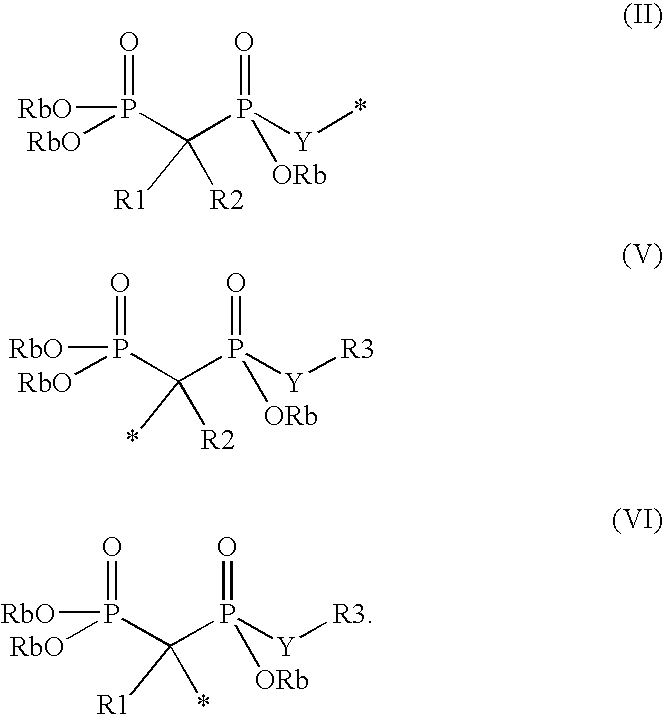Phosphate transport inhibitors
a phosphate transport inhibitor and inhibitor technology, applied in the direction of drug compositions, extracellular fluid disorders, chemical production, etc., can solve the problems of increased risk of cardiovascular events, serious side effects, and progression of renal failure, and achieve the effect of impaired phosphate transport function
- Summary
- Abstract
- Description
- Claims
- Application Information
AI Technical Summary
Benefits of technology
Problems solved by technology
Method used
Image
Examples
example 1
(n-decyl)phosphono chloridic acid, ethyl ester
[0068]
[0069] To a 500 mL round bottomed flask containing n-decylphosphonic acid diethyl ester, 22 g (79.0 mmol) was added to 100 mL of diethylether. This solution was stirred and cooled to −20° C. using an ice / salt water bath. Oxalyl Chloride (20.06 g, 158 mmol) was added in small portions over 45 minutes while maintaining the temperature at −20° C. The reaction mixture was then allowed to warm to room temperature and stirred for 24 hours. The solvent was removed by rotary evaporation to give a viscous liquid. The liquid was purified by vacuum distillation (boiling point: 126° C. at 0.4 mmHg) to give 15.5 g (73% yield) of the desired product. 1H NMR (400 MHz CDCl3): δ 4.2 (m, 2H), 2.0 (m, 2H), 1.6 (m, 2H), 1.2 (m, 17H), 0.75 (t, 3H).
example 2
((n-decyl)ethoxyphosphinyl)methylphosphonic acid dimethyl ester
[0070]
[0071] A 2.5 M hexane solution of n-butyl lithium (25.5 mL, 63.75 mmol) was added dropwise with stirring to methylphosphonic acid dimethyl ester (7.38 g, 59.55 mmol) in 130 mL of anhydrous tetrahydrofuran at −78° C. under nitrogen atmosphere. After the addition was complete (20 minutes) the reaction was stirred for 30 minutes. Then (n-decyl) phosphono chloridic acid, ethyl ester (8 g, 29.77 mmol) was added slowly while maintaining the reaction temperature at −78° C. After the addition was complete the reaction mixture was stirred for 60 minutes at −78° C. and then allowed to warm to −50° C. where the excess base was neutralized by the addition of saturated ammonium chloride. The reaction was allowed to warm to ambient temperature and stirred for a period of 16-20 hours. The volatiles were removed by rotary evaporation to give a viscous liquid. This liquid was diluted with water (75 mL) and extracted twice with dic...
example 3
((n-decyl)hydroxyphosphinyl)methylphosphonic acid trisodium salt
[0072]
[0073] Bromotrimethylsilane (2 mL, 15.15 mmol) was added dropwise to ((n-decyl)ethoxyphosphinyl)methylphosphonic acid dimethyl ester (0.6 g, 1.68 mmol) in a 30 vial. A large exotherm was noted which resulted in a clear solution that was stirred for 14-16 hours at ambient temperature. Excess bromotrimethylsilane was then removed by passing a steady stream of nitrogen over the solution for 2 hours. The solution was then placed under high vacuum for 3 hours to remove any residual bromotrimethylsilane. A tacky solid was obtained. Tributylamine (0.936 g, 5.05 mmol), methanol (10 mL) and deionized water (0.5 mL) was then added to the vial and a clear solution was obtained. This solution was then added dropwise to a 0.5 M solution of NaI in acetone (10.1 mL, 5.05 mmol). A white solid precipitated immediately which was then washed with 20 mL of acetone. The solid was filtered under vacuum and then washed several times wi...
PUM
| Property | Measurement | Unit |
|---|---|---|
| molecular weight | aaaaa | aaaaa |
| temperature | aaaaa | aaaaa |
| boiling point | aaaaa | aaaaa |
Abstract
Description
Claims
Application Information
 Login to View More
Login to View More - R&D
- Intellectual Property
- Life Sciences
- Materials
- Tech Scout
- Unparalleled Data Quality
- Higher Quality Content
- 60% Fewer Hallucinations
Browse by: Latest US Patents, China's latest patents, Technical Efficacy Thesaurus, Application Domain, Technology Topic, Popular Technical Reports.
© 2025 PatSnap. All rights reserved.Legal|Privacy policy|Modern Slavery Act Transparency Statement|Sitemap|About US| Contact US: help@patsnap.com



